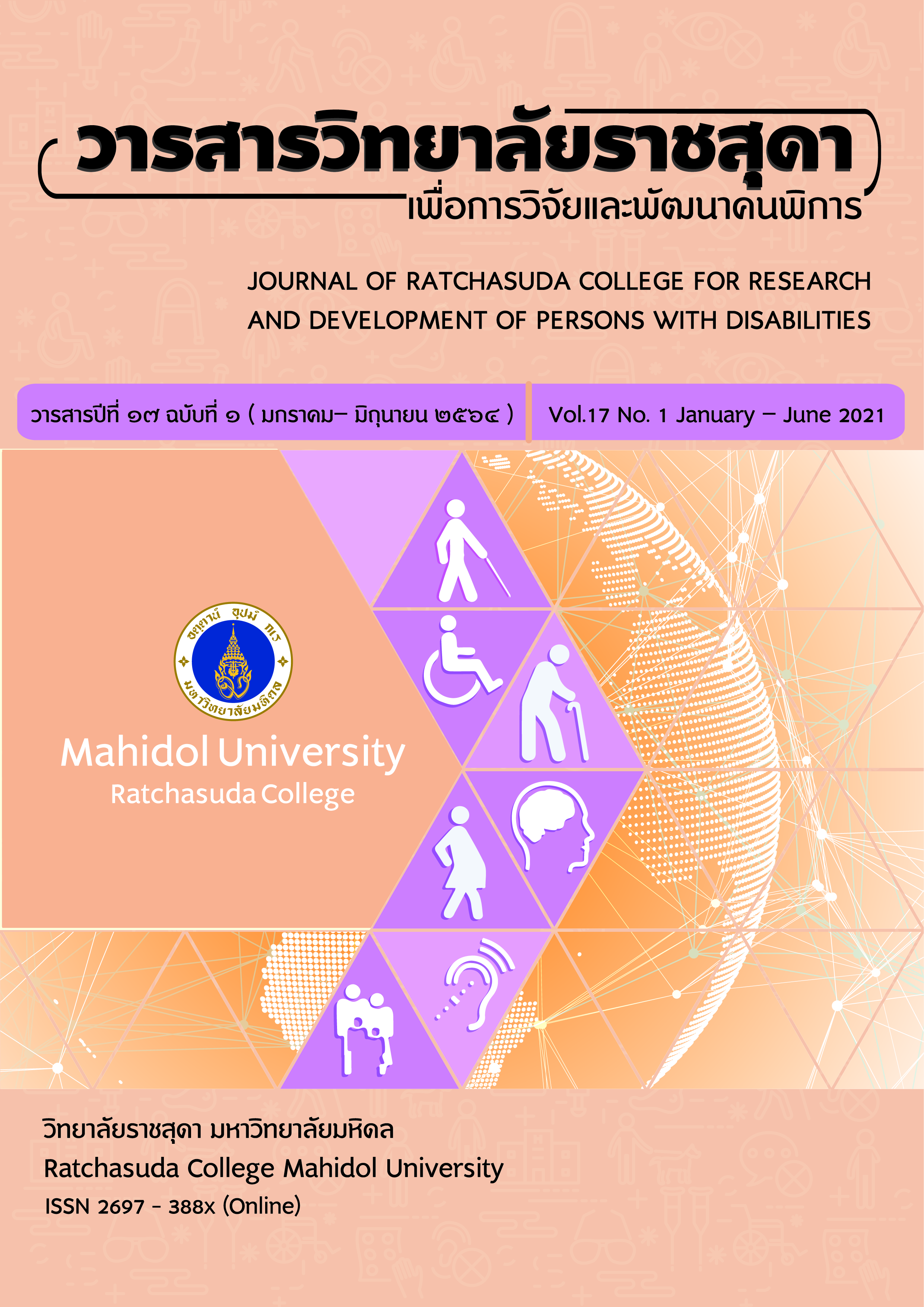การศึกษารูปแบบสนามฝึกอบรมเพื่อพัฒนาทักษะการทำความคุ้นเคยกับสภาพแวดล้อมและการเคลื่อนไหวสำหรับคนพิการทางการเห็น
คำสำคัญ:
คนพิการทางการเห็น,สนามฝึกอบรม, สนามฝึกอบรม, การทำความคุ้นเคยกับสภาพแวดล้อมและการเคลื่อนไหวบทคัดย่อ
งานวิจัยเรื่อง “การศึกษารูปแบบสนามฝึกอบรมเพื่อพัฒนาทักษะการทำความคุ้นเคยกับสภาพแวดล้อมและการเคลื่อนไหวสำหรับคนพิการทางการเห็น” มีวัตถุประสงค์เพื่อศึกษาแนวคิดด้านองค์ประกอบของสนามฝึกอบรมทักษะการทำความคุ้นเคยกับสภาพแวดล้อมและการเคลื่อนไหวสำหรับคนพิการทางการเห็นที่เหมาะสม ผู้วิจัยได้ใช้การวิเคราะห์ข้อมูลเชิงคุณภาพแบบสามเส้า พบว่า ขนาดของสนามที่ใช้ฝึกทักษะการเดินทางสำหรับคนพิการทางการเห็นทั้งสามกลุ่มมีความเห็นตรงกัน ไม่สามารถกำหนดขนาดพื้นที่ของสนามฝึกทักษะการเดินทางสำหรับคนพิการทางการเห็นที่เป็นมาตรฐานได้ ขึ้นอยู่กับสภาพแวดล้อมของแต่ละพื้นที่ (ถ้ามีขนาดเท่ากับสนามฟุตบอลมาตรฐานก็จะทำเส้นทางการฝึกได้มาก) การสอนการเดินทางให้กับคนพิการทางการเห็น ควรมีพื้นที่สภาพแวดล้อมในเมืองหรือชนบทองค์ประกอบที่สำคัญที่มีในสนามฝึกอบรมคนพิการทางการเห็นควรมีองค์ประกอบ ถนน ตรอก ซอย ทางแยก ทางข้าม สะพาน ฟุตบาทตามมาตราฐาน หญ้า พุ่มไม้ ต้นไม้ พื้นทางเดินแบบต่างๆ (คอนกรีต/ยางมะตอย/ลูกรัง/ดิน/น้ำ) ช่องทางเดินจัดให้เป็นไปตามสภาพจริง แต่ควรออกแบบให้มีพื้นผิวต่างสัมผัสตามสภาพจริง เช่น พื้นที่ราบเรียบ ขรุขระ แอ่งน้ำ เป็นเนินสูงๆต่ำๆ เป็นช่วงระยะทางสั้นบ้างยาวบ้างจะได้สร้างความคุ้นชิน ทางเดินคนเดียวขนาดไม่ต่ำกว่า 1ช่วงไหล่ (ประมาณ 80 เซนติเมตร) เพื่อที่จะใช้เทคนิคไม้เท้าในการสัมผัสพื้นผิวช่องทางเดิน และใช้ประสาทสัมผัสทั้ง 5 ในการรับรู้สิ่งต่างๆ สนามฝึกทักษะควรมี จุดสังเกต 2 แบบ คือ แบบถาวร และแบบชั่วคราว สนามฝึกควรมีสภาพแวดล้อมทั้งแบบในเมือง และแบบชนบท ส่วนด้านช่วงอายุที่เหมาะสมพบว่า คนพิการทางการเห็นมีด้วยกันสองกลุ่ม คนพิการทางการเห็นกลุ่มคนพิการทางการเห็นที่มีมาแต่กำเนิด และกลุ่มคนพิการทางการเห็นที่พิการภายหลัง เวลาการฝึกรอบละไม่ควรเกิน 3 ชั่วโมง (รวมเวลาพักแล้ว) และถ้าคนพิการทางการเห็นอยู่ในวัยเด็กต้องผ่านการเตรียมความพร้อมพื้นฐานในการเรียนรู้สิ่งต่างๆรอบตัว (การใช้สัมผัสทั้ง 5) มาก่อนการสอนการเดินทางส่วนใหญ่จะมีช่วงอายุประมาณ 10ปีขึ้นไป เวลาการฝึกควรฝึกทักษะรอบละไม่ควรเกิน1ชั่วโมง (รวมเวลาพักแล้ว)
Downloads
เอกสารอ้างอิง
American Foundation for the Blind: New York.
Cook, A., & Hussy, S. (2002). Assistive technologies : Principles and practice. New York.
Fazzi, D. L., Blasch, B. B., Sauerburger, D., & Millar, D. (1996). Can person who are blind or have other disabilities safely and effcetively teach orientation and mobility. Point/Counterpoint.[CD-ROM].Abstract from: ERIC-1993-June 2002 (2002, November 13).
Higgins, Nancy. (1999). The O & M in my life : Perceptions of people who are blind and their
parent. Journal of Visual Impairment & Blindness, 93(9), 561-578.
Langton, A. J. (1998). Guide to using assistive technology in assessment and vocational
evaluation. Center for Rehabilitation Technology Services SC Vocational Rehabilitation Department.
Morais, M., Lorensen, P., Allen, R., Bell, E. C., Hill, A., & Woods, E. (1997). Techniques
used by blind cane travel instructors : A practical approach : Learning, teaching,
believing. Baltimore, MD.: National Federation of the Blind.
Office of the National Education Commission (1999). National education act B.E. 2542
(1999). Office of the National Education Commission. Office of the Prime Minister, Kingdom of Thailand. Mosby.
Suwatchai Chanheng. (2010). The development of blended training model for teachers
who teach orientation and mobility to students with visual impairment. A Thesis
Submitted in Partial Fulfillment of the Requirements for the Degree Doctor of
Philoosophy. Department of Curriculum and Instruction Graduate School Silpakorn University.
ดาวน์โหลด
เผยแพร่แล้ว
รูปแบบการอ้างอิง
ฉบับ
ประเภทบทความ
สัญญาอนุญาต
บทความที่ได้รับการตีพิมพ์เป็นลิขสิทธิ์ของวารสารสถาบันราชสุดาเพื่อการวิจัยและพัฒนาคนพิการ






